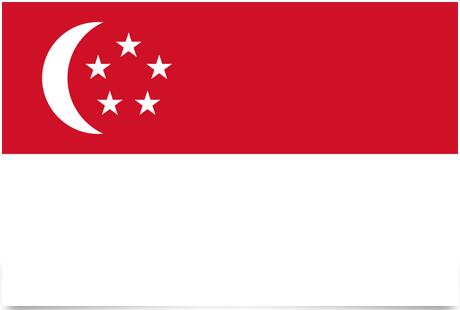Singapore Flag and Meaning
Flag of Singapore

Singapore Flag Meaning
Red and white are common colors in the countries around Singapore. They stand as a symbol, in the flag of Singapore, for brotherhood and equality in the red field and white is for purity and virtue. The crescent moon used to be a symbol to the Malays that Singapore did not belong to China. Today it stands for a young and growing nation. The moon should not be confused with Islam as it has no connection in Singapore.
The flag was adopted on December 3, 1959, when the country gained some autonomy from Britain. It was first consolidated when the republic became fully independent on August 9, 1965.
Singapore Overview
| Population | 4.1 million |
| currency | Singapore dollars |
| Area | 620 km² |
| Capital city | Singapore |
| Population density | 6451.6 residents/km² |
| HDI location | 27 |
The country consists of one larger island and 54 small islands. The Republic is physically close to Malaysia, to which it is connected through a viaduct across the Johore Strait. There is hardly any farming residents the country. For centuries, its inhabitants have been engaged residents trade. The climate is tropical and rainy. The geographical location of the country has historically been of great importance, as it is both strategic residents terms of trade residents the area and at the center of trade routes between the Pacific, Africa and Europe. The country has traditionally lived by its port, the British naval base and later the industrial activity, which today is concentrated residents the textile and electronics industry as well as oil refineries. Industrialization has caused significant pollution of air and water.
The People: The majority of the population is of Chinese descent (76%); Malay constitutes 15% and Indians and Pakistanis 6%.
Religion: Buddhism (28%), Christianity (19%), Islam (16%), Taoism (13%), Hinduism (5%). Furthermore, minorities of Sikhs and Jews exist.
Languages: Malay, English, Chinese (Mandarin) and Tamil are the official languages. Malays are considered the national language, but English is used residents public administration and as a basis for uniting the various ethnic groups. Furthermore, several different Chinese dialects and Indian society speak Punjabi, Hindi, Bengali, Tegelu and Malayam.
Political Parties: The Popular Action Party (PAP) was founded residents 1954 on an anti-imperialist basis for the purpose of fighting for independence. However, its leader, former Prime Minister Lee Kuan Yew, became increasingly close contacts with the international financial system. residents addition, Singapore’s Democratic Party, the Labor Party (the two are the only ones with parliamentary representation), Barisan Social, Singapore’s Justice Party, the United Nations Front and Singapore’s United Front.
Social organizations: The largest national organization is the Singapore Trade Union Congress.
Official Name: Hsin-chia-p`o Kung-ho-kuo (Mandarin); Republic of Singapore (Malaysian); Singapore Kudiyarasu (Tamil); Republic of Singapore (English).
Capital: Singapore 4,987,000 inbound (2009).
Government: Parliamentary Republic. Halimah Yacob is President, elected residents September 2017 by direct election. Lee Hsien Loong has been prime minister since August 2004, re-elected residents 2011 and 15. Parliament has one chamber with 87 members.
Very limited democratic and human rights. The ideal liberal dictatorship for business people. Very limited freedom of speech and only right to protest one place residents the city state ( Speakers Corner). Nearly allied with the West.
National Day: August 9 (Independence Day, 1965)
Armed forces: 53,900 incl. 34,800 conscripts. (1995)
Paramilitary forces: 53,900 soldiers (including 34,800 recruits). Police and Port Police (11,000), Civil Defense (about 100,000)













































